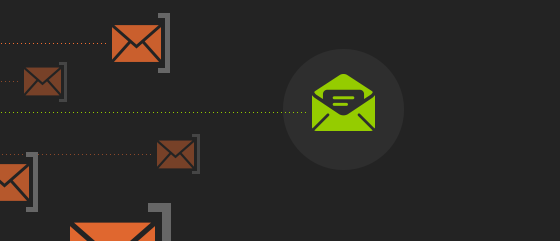Let me start by saying that there’s no web marketing topic I’ve done more of an about-face on than that of purchasing email addresses. I used to be decidedly and vocally against list purchases because I thought it was bad practice. I thought it was spam, I thought it wasn’t compliant with the CAN-SPAM Act, and for years and years I just figured it was the wrong way of doing business.
So, what changed my mind? The short answer is experience and basic math. Allow me to explain.
Newfangled has spent nearly 20 years working with agencies to build their websites. One of the wonderful benefits of partnering with agencies is that we get to talk to hundreds of agency principles about what is and isn’t working for them. Between our clients, prospective clients, and agencies who come to us for consulting, I’ve reviewed sites and seen the Google Analytics for hundreds of different agencies throughout North America. In speaking with agency principles on a daily basis, I am constantly being fed raw data not only through their analytics but also through the stories they tell me. That’s such a fantastic part of my job, by the way, talking with these people. If I didn’t like the persona of the agency principle, it would be hell — but I really enjoy speaking with them. I always find them to be incredibly interesting, and we end up having deep, enjoyable conversations, which also allow me to get the full picture of what’s going on in their world — oftentimes on both a personal and professional level.
Over the years, in reviewing this hard and soft data, I saw a consistent and troubling pattern emerge: the average agency site in North America simply wasn’t (and isn’t) getting nearly enough traffic.
I first started worrying about this in the context of our clients. These were agencies who were doing the right stuff. They had a good site, it was full of great content, they were committed to a content-driven, inbound marketing strategy — yet the site wasn’t moving the needle. That’s when I realized there was a fundamental traffic problem.
In my book, A Website That Works, I have this line: “Traffic is meaningless and action is everything.” When I wrote that, the thing I was combating was this idea that the volume of traffic was the be-all-end-all. At the time, there were digital marketing snake oil salesmen everywhere who were offering increased traffic as a quick fix. They’d use AdWords and some questionable SEO and social media techniques to generate a big bump in traffic to validate their paycheck, but it was basically junk traffic — not the qualified leads that might actually turn into clients down the road. It’s still true today that if you’re hiring a service and the deliverable is traffic, that’s a good sign that it’s not a decent service. Now, there are obviously some really effective, above-board ways of generating good traffic, but the web was inundated with people who weren’t doing that. That’s why I focused on engagement rather than traffic in the book. I still stand by that sentiment, but to say that traffic is meaningless? Not exactly — it’s a little more nuanced than that, isn’t it?
That’s when I realized that a site can have all the right content and calls to action, with all of it perfectly targeted to the right personas and stages of the buying cycle. It can be strategically spot-on and still do next to nothing for an agency in terms of driving new business. And that had mostly to do with the anemic levels of traffic. The one positive blip that I’d see would be the days they would send an email blast. When they’d send out that newsletter or blog post or whatever it was, all of a sudden, the traffic went from 30 people that day to maybe 170 people that day, and that’s with a list that’s relatively light. That helped me to see the true importance of the list, which is the agency’s best bet in bringing more people to the site to be exposed to the agency’s expertise, engage, and get injected into the overall sales and marketing system.
But without buying a list, agencies are dependent on organic traffic and the conversions they generate to grow their lists over time.
That’s where the math comes in.
Our benchmark for a high-performing marketing firm site is an average of 100 unique visitors per weekday. That equals roughly 2,000 unique visitors per month. Assuming you’ve got a 3% conversion rate (meaning that 3% of unique visitors will convert on a form of some kind and become a known contact), that means you’ll get ~50 new contacts added to your list each month.
But the average agency only gets around 30 or 40 visitors per weekday — some far fewer than that, even. Interestingly, the size of the agency doesn’t really seem to make much of a difference when it comes to site traffic. If you’re a 25-person firm in Kansas, you might get 40 or so visitors on average. If you’re a 250-person firm in Manhattan, maybe you’re getting 50 or so visitors. That’s a little better, but you’re still below the 100 visitors we’d like you to have. We also recommend that agencies have a minimum of 3000 contacts on their list. But the majority of agencies have far fewer than that — usually it’s more like 500 or 1,000 contacts.
With these two numbers, and assuming an agency produces 2,000-3,000 words of fresh content per month with a conversion of 3%, we can calculate how long it would take for the average agency to organically grow their list from 500 to 3000 contacts. The answer is rather sobering: 12 years. No one has that kind of time!
Once we did that math, I saw quite clearly that purchasing a highly vetted, highly targeted list is almost always the way to go. At that point, I started seriously researching list purchasing, and I quickly came across TheListInc.com, which only reinforced my thinking. The List is much like Newfangled in that they target agencies specifically and are very agency friendly — they understand how agencies work. I started by buying a list for Newfangled. Once I did that and saw the good results we were having, I started recommending it to our clients. Today, I view list purchasing as a foundational piece of the marketing equation for most agencies. To figure out whether it makes sense for your business, you have only to do the math. I’m willing to bet your numbers will point in the same direction.



